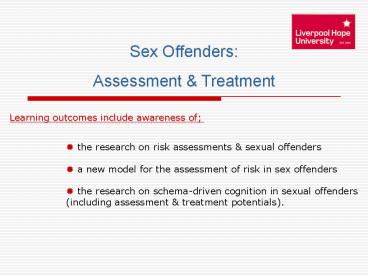Sex Offenders: - PowerPoint PPT Presentation
1 / 17
Title:
Sex Offenders:
Description:
'Sexual offenders, like everybody else, choose their conduct based on their ... A model of recidivism risk among sexual offenders, Cited in: Hanson (2006, p.21) ... – PowerPoint PPT presentation
Number of Views:1029
Avg rating:3.0/5.0
Title: Sex Offenders:
1
Sex Offenders Assessment Treatment
- the research on risk assessments sexual
offenders - a new model for the assessment of risk in sex
offenders - the research on schema-driven cognition in
sexual offenders (including assessment
treatment potentials).
Learning outcomes include awareness of
2
Sexual Offenders
Hanson (2006)
Sexual offenders, like everybody else, choose
their conduct based on their perception of the
options available. Sexual offenders differ from
many other people, however, by perceiving certain
situations as ones in which a sexual crime is a
legitimate option. Later, sexual offenders may
wonder why they did it, but at the time, the
sexual offence was perceived as something they
could (should?) do (p.20).
3
Concepts of Risk
Sexual Offence Triggers
- Static risk factors - enduring propensities, or
potentials to reoffend (e.g. prior offences,
childhood maladjustments etc ). - Dynamic risk factors - factors that indicate the
onset of new offences (e.g. deviant sexual
preferences, cooperatation with supervision
etc).
4
Acute Risk Factors
Hanson Bussiere (1998)
- Sexual deviance sexual interest in children,
any deviant sexual preferences, prior sexual
offences, stranger victims, early onset sex
offending, unrelated victims, boy victims,
diverse sex crimes. - Criminal history/lifestyle anti-social
personality disorder/psychopathy, prior
(non-sexual) offences. - Demographic factors age (young), single (never
married). - Demographic factors failure to complete
treatment.
5
Dynamic Risk Factors
Sexual arousal
A sex offence schema
Victim access Situational cues
Subjective distress
Deviant fantasies Plans Schemata scripts
Intimacy problems
Sexual offending
Attitudes Values
A model of recidivism risk among sexual
offenders, Cited in Hanson (2006, p.21)
6
The 5 Domain Assessment Model
- Sexual deviance
- Criminality
- Social competence
- Substance abuse
- Treatment readiness
Abracen, Mailloux, Serin, Cousineau (2004)
7
The Study.
Study population 512
- Rapist (n 166)
- Child molesters ( n 168)
- Incest offenders (n 178)
8
Variability of Static Dynamic Factors
Between group differences
- Age at index offence no significant difference
- Number of victims rapists lt than child
molesters/incest offenders. - Criminality rapists gt child molesters gt incest
offenders - Social competence incest offenders gt child
molesters gt rapists - Sexual deviance child molesters/incest
offenders gt rapists - Substance abuse rapist gt child molesters/incest
offenders
9
Classification Predictive Variables
Associated variables/factors
- Offender Type - sexual deviance substance abuse
- Severity of offending behaviour - criminality,
sexual deviance substance abuse - Level of risk - criminality, social competence
substance abuse
10
The Sex Offence Schema
Sexual arousal
Victim access Situational cues
Subjective distress
Deviant fantasies Plans Schemata scripts
Intimacy problems
Sexual offending
Attitudes Values
11
Hansons (1998) Sex offence Schema
Elements of the sex offence schema
- Egocentric self-perception
- Sex overvalued in the pursuit of happiness
(including a link between sex and power) - An ability to justify to oneself that some people
deserve to be victimized
12
Sexual Offenders Dysfunctional Schemas
- Hostile masculinity schema aggressive
adversarial schemas about intimate relationships
between men and women. Fail to develop protective
pro-social skills (e.g. ability to manage
frustration negotiate conflict) and through
(learnt) sexual promiscuity, sexual conquests
become a source of identity. and can lead to
sexual aggression (Malamuth, Heavy Linz, 1993). - Suspiciousness schema believes women are
game-playing deceptive people who use aggression
as a form of seduction, and who are deceitful
when they behave seductively (Malamuth Brown,
1994). - Sexual entitlement schema a person should have
sex whenever it is needed women should oblige
mens sexual needs (Hanson, Gizzarelli Scott,
1994) - Dangerous world schema sees authorities as
controlling and punitive, spouses as deceitful,
outsiders as hostile, that nobody can be trusted,
I need to fight back, physical force gets respect
if you dont get even people will walk over you
(Mann Shingler, 2006)
13
Sexual Offenders Dysfunctional Schemas (cont)
Myers (2000)
- Rapists distrust of women need for control
- Child molesters worthlessness a passive
victim stance. - Violent (non-sexual) offenders protector of
others
14
Sexual Offenders Dysfunctional Schemas (cont)
Mann (2004)
Dominance schemas
Disadvantaged schemas
Desire for vengeance
Need for control
Feels damaged by the actions of others
Controlled by past negative experiences
15
Mann (2004) Results
- Low schema-reporting (n 175) these offenders
indicated that none of schema were characteristic
of their thinking. - Average schema-reporting (n 92) one schema
may be characteristic of their thinking - Submissive cluster (n 151) characterised by
particularly low levels of dominance schema. - Hypercharged cluster (n 62) characterised by
all four schemas being primed.
16
Dysfunctional Schemas Assessment Treatment?
Mann Shingler (2006)
- Assessments Life maps (life histories)
- Treatment aim is not to change schema but
rather to help offenders recognise their schemas
and view them as hypotheses to be tested rather
than absolute truths.
17
Sexual Offender Treatment?
for too long we have pretended, while knowing
otherwise, that all offenders reflect one
offence process or pathway. This must affect how
well treatment needs were determined and met,
which in turn may well have affected efficacy
(Laws, Hudson Ward, 2000, p.22).































